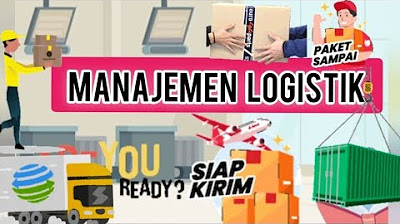SIKLUS KEGIATAN LOGISTIK DAN PERGUDANGAN
Summary
TLDRThis video provides a detailed tutorial on logistics and inventory management, emphasizing the key stages in the logistics cycle: planning, budgeting, procurement, receiving goods, storage, distribution, and disposal. The speaker explains the importance of clear planning, efficient budgeting, and risk management in procurement. Distribution is highlighted through the Just-In-Time (JIT) method for efficiency. The tutorial concludes by stressing the importance of proper disposal procedures and maintaining guidelines throughout the cycle to ensure smooth operations and regulatory compliance.
Takeaways
- 😀 The first step in the logistics cycle is planning the needs for inventory and activities, ensuring everything is well-prepared and funded.
- 😀 Budgeting follows planning, ensuring that the necessary funds are available for executing the planned activities in logistics management.
- 😀 Procurement or purchasing is the next step, focusing on acquiring goods and services according to a well-defined process with clear guidelines.
- 😀 Once the procurement process is completed, goods are received at the warehouse, where the responsibility shifts to storage, maintenance, and protection of the items.
- 😀 Warehouses play a critical role in securing and managing inventory, including ensuring the safety and upkeep of goods during storage.
- 😀 Distribution involves the efficient and timely delivery of goods to their destinations, focusing on Just-in-Time delivery to ensure cost-effectiveness and precision.
- 😀 Logistics management emphasizes that the distribution should be on time, within budget, and to the right destination, ensuring operational efficiency.
- 😀 The final step in the logistics cycle is the disposal of items that are no longer needed or have reached the end of their useful life, following a strict approval and regulation process.
- 😀 Each stage of the logistics cycle, from planning to disposal, must follow clear rules and guidelines to ensure smooth operations and prevent issues.
- 😀 The entire logistics cycle is interconnected, and careful attention must be paid to each step, including planning, budgeting, procurement, warehousing, distribution, and disposal.
Q & A
What is the first step in the logistics cycle?
-The first step in the logistics cycle is **planning** the logistics activities, which includes determining the required materials and resources, and ensuring adequate funding for the activities.
Why is planning important in the logistics cycle?
-Planning is crucial because it sets the foundation for all subsequent activities. It helps ensure that the necessary resources and funding are available, and it minimizes the risk of any issues arising later in the process.
What comes after planning in the logistics process?
-After planning, the next step is **budgeting**, where the necessary funds are allocated to support the planned logistics activities.
What does the budgeting process involve?
-The budgeting process involves preparing the required funds based on the logistics plan to ensure that all activities can be executed smoothly without financial constraints.
What role does procurement play in logistics management?
-Procurement involves acquiring the goods and services needed for the logistics process. It's important that this process follows clear guidelines to ensure efficiency and avoid any risks or mistakes.
How is procurement related to warehouse activities?
-Procurement is related to warehouse activities because once the goods are purchased, they are delivered to the warehouse for **receiving** and **storage**, where they will be managed and maintained.
What happens during the receiving process in logistics?
-During the receiving process, the warehouse accepts the delivered goods, checks their condition, and stores them properly for future use. The warehouse is responsible for maintaining the goods in optimal condition.
What is the importance of distribution in logistics?
-Distribution is important because it ensures that the goods reach the correct destination, on time, within budget, and in the required quantity, thus enabling efficient utilization by the users or units.
What is the Just-in-Time method, and how does it relate to distribution?
-The Just-in-Time (JIT) method is a distribution strategy that focuses on delivering goods exactly when they are needed, in the right amount, and with minimal cost. It is designed to optimize the timing and efficiency of deliveries.
What happens at the end of the logistics cycle?
-At the end of the logistics cycle, the final step is **disposal**, where goods that are no longer useful, damaged, or obsolete are removed according to approved procedures and regulations.
How is the process of disposal regulated?
-The disposal process is strictly regulated and requires proper approval before items can be discarded. There are clear guidelines and regulations in place to ensure that the disposal is carried out correctly and in compliance with legal and operational standards.
Outlines

Dieser Bereich ist nur für Premium-Benutzer verfügbar. Bitte führen Sie ein Upgrade durch, um auf diesen Abschnitt zuzugreifen.
Upgrade durchführenMindmap

Dieser Bereich ist nur für Premium-Benutzer verfügbar. Bitte führen Sie ein Upgrade durch, um auf diesen Abschnitt zuzugreifen.
Upgrade durchführenKeywords

Dieser Bereich ist nur für Premium-Benutzer verfügbar. Bitte führen Sie ein Upgrade durch, um auf diesen Abschnitt zuzugreifen.
Upgrade durchführenHighlights

Dieser Bereich ist nur für Premium-Benutzer verfügbar. Bitte führen Sie ein Upgrade durch, um auf diesen Abschnitt zuzugreifen.
Upgrade durchführenTranscripts

Dieser Bereich ist nur für Premium-Benutzer verfügbar. Bitte führen Sie ein Upgrade durch, um auf diesen Abschnitt zuzugreifen.
Upgrade durchführen5.0 / 5 (0 votes)






